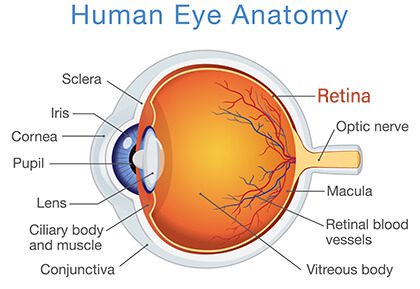
What is the retina?
The retina is a thin membrane on the back of the eye that is lined with photoreceptor cells. These light-sensitive cells function to process light and convert it into neural signals that are sent to the brain for visual recognition.
Why is the retina important?
The retina plays a critical role in vision — if it is damaged, the brain won’t be able to receive visual information, which can result in permanent blindness. Often, the first signs of damage are hard to notice. By the time you notice a decrease in vision quality, the damage is irreversible.
It’s very important to monitor your eye health so retinal conditions can be detected and treated as early as possible. The best way to evaluate retinal health is to schedule regular exams with an eye care professional. If a retinal condition is caught early, your doctor can develop a treatment plan to prolong your vision.
What are common retinal conditions?
There are many conditions that can affect your retina, but some are more common than others.
Here are the eye conditions most likely to cause retinal damage:
– Diabetic Retinopathy: Symptoms of uncontrolled diabetes can affect your retinal health. High blood sugar levels can cause the blood vessels in the retina to swell. When the vessels swell too much, they can start to leak and cause damage to the retina.
– Macular Degeneration: Age-Related Macular Degeneration is one of the most common retinal conditions. It occurs when the photoreceptor cells in the macula — the center of the retina — begin to break down. As a result, central vision begins to fade.
– Retinal Tear or Detachment: The vitreous, a gel that fills most of the eye, can sometimes shrink and pull the retina with it. This can result in a retinal tear or a complete detachment. When this happens, the symptoms are often immediate and include the sudden appearance of floaters in your field of vision. If you experience a tear or detachment, you should seek treatment immediately, as they are considered a medical emergency. If not immediately treated, a detachment can cause permanent blindness.
How do you maintain a healthy retina?
One of the best ways to maintain a healthy retina is to have good health in general. An active lifestyle and proper nutrition can help lower your risk of retinal disease, in addition to staying consistent with routine eye examinations. Since retinal damage is irreversible by the time your vision declines, early detection and treatment is the best way to prevent vision loss.
What happens during a retinal exam?
Most regular eye exams include a retinal exam. A comprehensive eye exam may include a detailed retinal scan using Ocular Coherence Tomography (OCT). This test uses infrared technology to provide detailed images of the retina, which are typically better for detecting early stage retinal damage. Your doctor will recommend the tests that are right for you.
How often should you have an eye exam?
Adults ages 18-55 should schedule a comprehensive eye exam at least once every two years to check for changes in vision and to assess for a variety of eye conditions. Annual exams are recommended for adults over age 55 and individuals who are considered “at risk.” In addition to age, risk factors include eye injuries, complications from a surgery, diabetes, or a family history of eye disease.
If you experience problems with your vision, consult your eye doctor as soon as possible — don’t wait until your scheduled appointment. A sudden change in your eyesight could indicate a serious problem that requires immediate attention. Contact emergency services if your eye doctor isn’t available.
How do you treat a retinal condition?
There are a variety of treatment options for retinal damage. Treatment is typically most effective when used as early as possible to prevent further damage.
These treatments include:
– Anti-VEGF Injections: Certain medications can be injected into the eye in order to stop the growth of abnormal blood vessels as a result of diabetic retinopathy. Anti-VEGF medications target the Vascular endothelial growth factor, or VEGF, which is a type of protein that causes abnormal vessel growth in patients with diabetic retinopathy.
– Vitrectomy: The vitreous can cause issues when it pulls on the retina. A vitrectomy removes the gel-like substance and replaces it with an oilier substance that reduces the amount of tension it has on the retina.
– Focal or Scatter Laser Photocoagulation: One of the most common surgical methods used to treat diabetic retinopathy is laser surgery. Either a focused laser or a scattered laser is used to seal off leaking blood vessels in the retina, which causes the abnormal blood vessels to shrink and minimize damage.




Need a last minute recipe to bring to the holiday gathering? This one is filled with healthy fruits good for you AND your eyes! ... See MoreSee Less
0 CommentsComment on Facebook
Need a last minute gift for the person who is difficult to shop for? Have you thought about their vision? Whether it is a brand new pair of frames from one of our optical boutiques or a certificate for vision correction, we have the unique gift for your loved one who has everything, including poor vision! Stop in to one of our Island locations today! ... See MoreSee Less
0 CommentsComment on Facebook
Dry eyes can be more than just a temporary annoyance. They may be a sign of ocular surface disease, a common condition where your eyes don’t produce enough tears or the right kind of tears. 👁️💧 We are here to help with advanced dry eye treatments! ... See MoreSee Less
1 CommentComment on Facebook
𝐖𝐢𝐬𝐡𝐢𝐧𝐠 𝐲𝐨𝐮 𝐚 𝐬𝐩𝐞𝐞𝐝𝐲 𝐫𝐞𝐜𝐨𝐯𝐞𝐫𝐞𝐫, 𝐢𝐧 𝐭𝐡𝐞 𝐦𝐞𝐚𝐧𝐭𝐢𝐦𝐞 , 𝐢 𝐰𝐢𝐥𝐥 𝐚𝐝𝐯𝐢𝐜𝐞 𝐲𝐨𝐮 𝐭𝐨 𝐠𝐞𝐭 𝐢𝐧𝐭𝐨𝐮𝐜𝐡 𝐰𝐢𝐭𝐡 𝐃𝐫 *Ogbekhiulu* #DrogbekhiuluherbalHome 𝐦𝐞𝐝𝐢𝐞𝐬, 𝐡𝐢𝐬 𝐭𝐫𝐞𝐚𝐭𝐦𝐞𝐧𝐭𝐬 𝐚𝐧𝐝 𝐧𝐚𝐭𝐮𝐫𝐚𝐥 𝐦𝐞𝐭𝐡𝐨𝐝𝐬 𝐠𝐚𝐯𝐞 𝐦𝐞 𝐜𝐨𝐦𝐩𝐥𝐞𝐭𝐞 𝐚𝐧𝐝 𝐩𝐞𝐫𝐦𝐚𝐧𝐚𝐧𝐭 𝐫𝐞𝐥𝐢𝐞𝐟 𝐟𝐫𝐨𝐦 𝐦𝐲 𝐬𝐢𝐦𝐢𝐥𝐚𝐫 𝐬𝐲𝐦𝐩𝐭𝐨𝐦𝐬
The holiday season is full of sparkle—but a few festive favorites can put your eyes at risk. 1. Champagne Corks 🥂 Celebratory toasts can turn dangerous fast. A champagne cork can launch up to 50 mph, causing serious eye injuries. 2. Sharp Tree Branches & Pine Needles 🎄
Decorating the tree often means leaning in close—and those stiff branches can scratch the eye’s surface, leading to painful corneal abrasions. 3. Flying Toys & Projectiles 🎯
Nerf guns, darts, drones, and remote-control gadgets are holiday favorites—but also common causes of eye injuries in ERs every December. 4. Glitter, Craft Supplies & DIY Décor ✨
Holiday crafts are fun, but glitter, adhesives, and decorative sprays can irritate the eyes or cause chemical injuries. 5. Dry Winter Air & Holiday Travel ✈️❄️
Heaters, cold air, and long flights can leave eyes dry, red, and irritated—especially for contact lens wearers.
Take care of your eyes this season! ... See MoreSee Less
0 CommentsComment on Facebook
We appreciate our teams and our highly trained doctors who are available to see patients quickly for urgent needs. Your eyes are precious, we are here to help!
#TestimonialTuesday ... See MoreSee Less
0 CommentsComment on Facebook
Hau'oli Lā Ho'omaika'i! ... See MoreSee Less
0 CommentsComment on Facebook